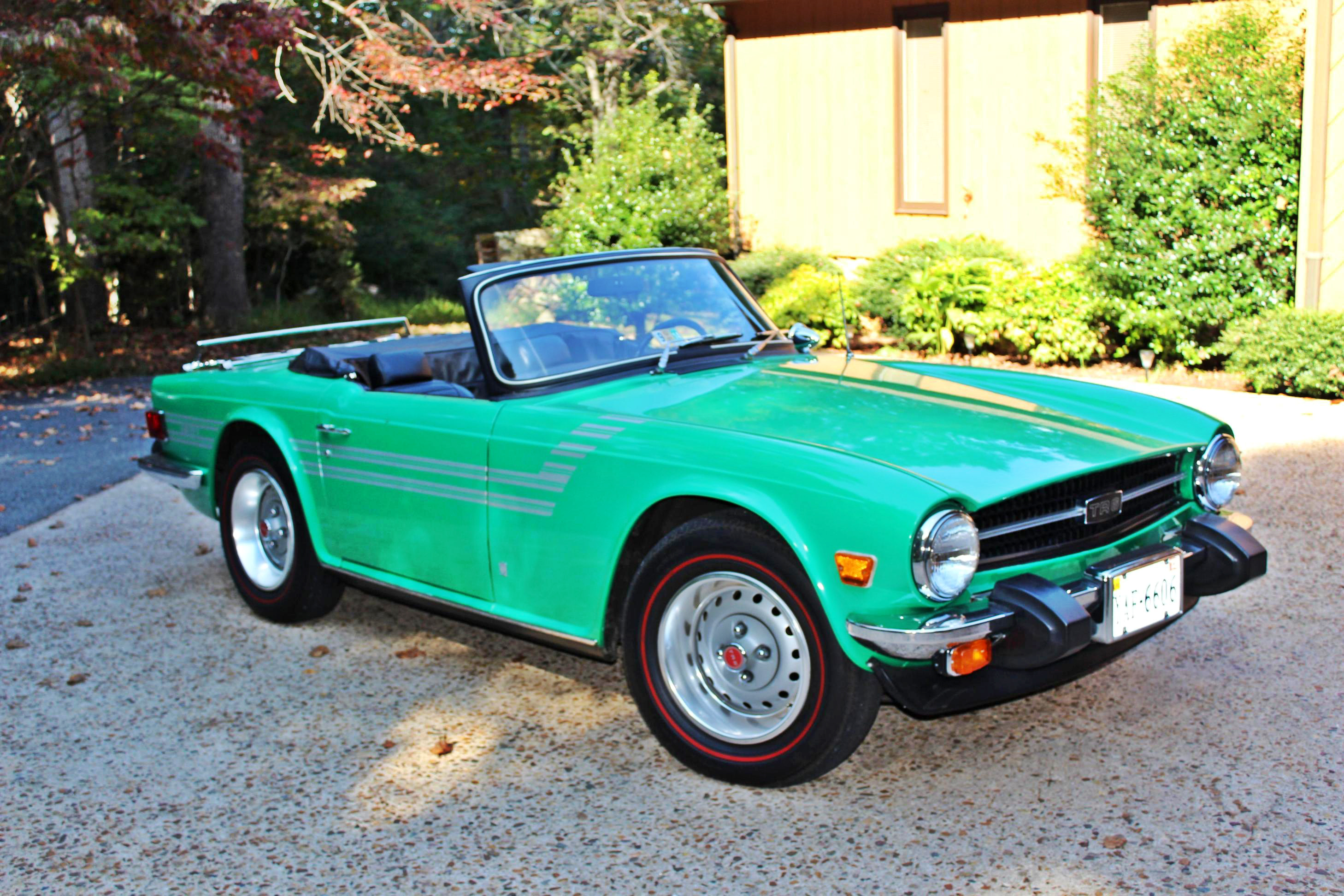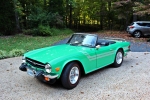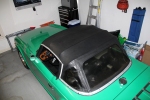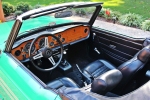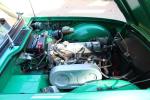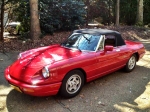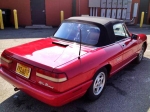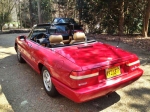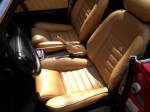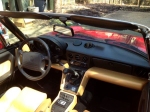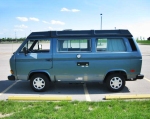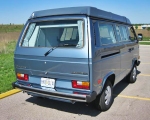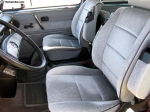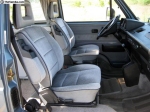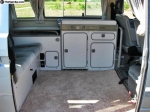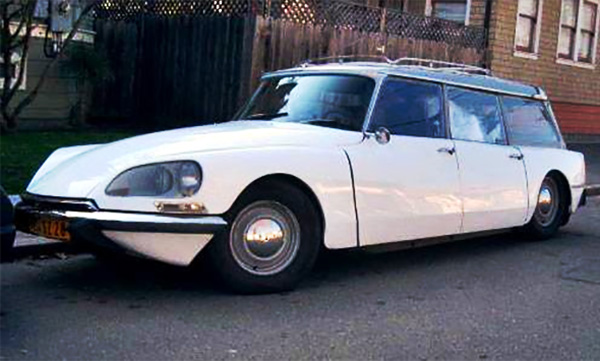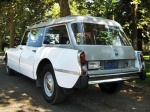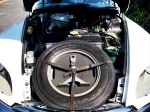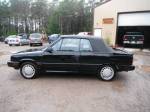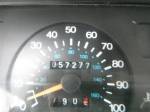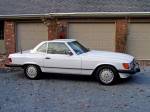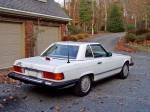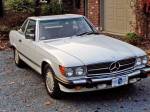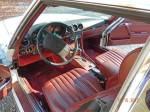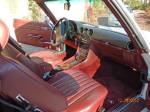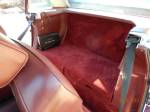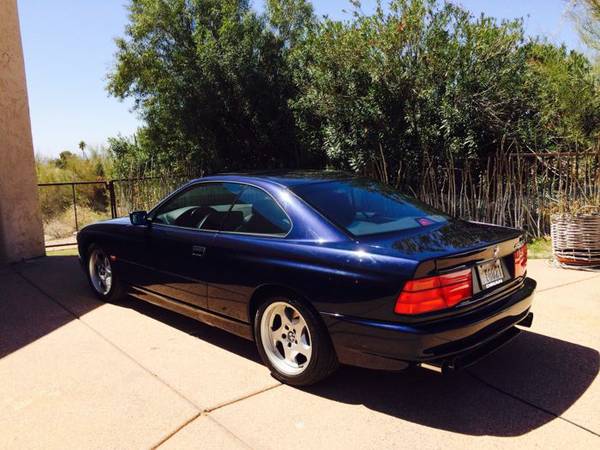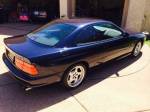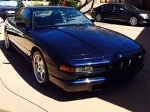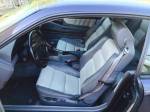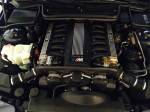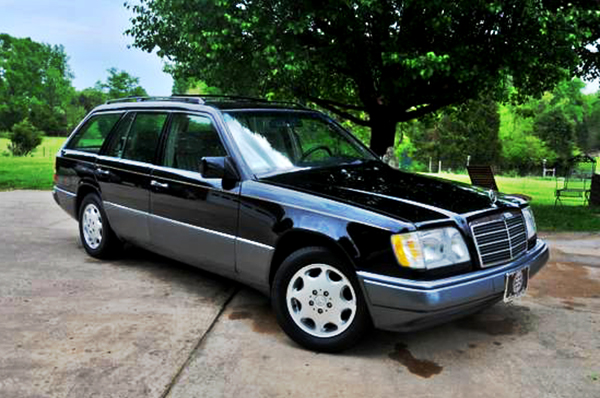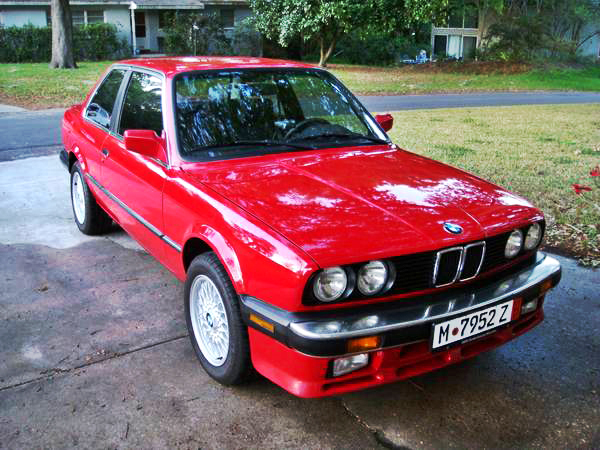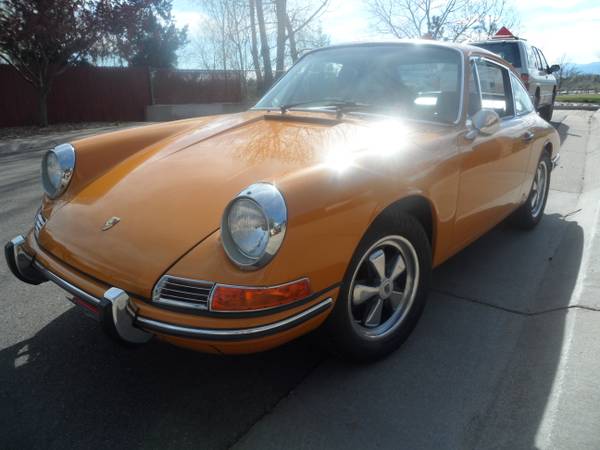Despite being the most popular in Triumph’s TR series, with nearly 100,000 made, the TR6 is also the one with perhaps the best investment potential. The early TRs—the TR2 and TR3—are already seeing some nice returns, which they’ve earned as being among the first to gain worldwide popularity and thus helped to create the British Roadster as a motoring genre. That said, they, like many of their contemporaries, were based on pre-war mechanics—chiefly tractors and other farm implements. Although the TR4 saw a significant styling change with a handsome design by Michelotti (who penned several early Ferraris), the engine was more or less unchanged until 1967. With the introduction of the low-production TR250 (TR5 rest of world), the 4-cylinder was replaced with a more modern inline 6. The US retained twin Zenith-Solex carbs while everyone else got petrol injection (115 bhp vs. 150). This motor carried over into the Karmann-styled TR6, which became further hampered in the US by emissions regulations to a mere 104 hp. British Roadster motoring wasn’t really about horsepower and the TR6, even in US form, managed to live up to what it was about: fun, easy, breezy, and affordable. Having said that, the rules that apply any British Roadster are no different with a TR6: 1.) buy the best you can afford; and 2.) you can’t afford a cheap one. Rust is a common problem, notably the pans and along the links of the rear suspension. What may appear to be an easy fix can easily run into the thousands as they are more complex than one might think and not easy to put back together. Generally, the motors are quite solid, but if there is a need to get inside, it does require an engine-out service. Electrical systems are typical British finicky, but again, a TR6 that has been properly cared for will be less likely to create problems down the road. Another option is to buy one that’s practically new and care for it yourself. That, in essence, is what we have here. This is a final-year 1976 TR6 that is completely original with an astonishing 12,000 miles. It has original paint, original decals, original top, original manuals, original tools, original tonneau, you get the idea. While there are conditions under which miles can be too low, the seller states hoses and rubber have been replaced as needed to prevent leaks and decay. This was also the era when the TR6 stood out with bright colors like Topaz Yellow, Tahiti Blue and this Java Green. It may not be everyone’s cup of tea, but it is a nice change from the red, maroon and dark blue we so often see. Prices on all TR6s have been steady over the last decade with a recent upturn. No. 1 cars have risen the sharpest and this surely isn’t far from that if it’s not already there. Preserve for posterity or enjoy as nearly new. Not a bad investment either way. Find it here on Craigslist in Forest, VA for $25,000, with a link to the seller’s site here.
Tag: low miles (Page 3 of 5)
Over its 30-year production run, the Type 105 Alfa Romeo Spider captured the essence of La Dolce Vita as no other car before or since. Associated with Italian movie stars and a movie star in its own right—appearing in films like Under The Tuscan Sun, Wayne’s World, Fletch, and of course The Graduate—it was stylish, nimble, sporty, and radiated a spirit of carefree adventure. From the iconic boat-tailed Duetto to the Kammbacks to the more unified design of the final series, they remained more or less unchanged in their appearance, whilst engine choices ranged from the early cars’ twin-cam 1600 to the lively 2.o litre motors with Motronic injection used in the Series 4. These last Spiders, produced from 1990-1994 are the most refined, with wraparound taillights and body-colored bumpers and side moulding, along with the aforementioned Bosch EFI motors that significantly improved reliability and power band, making these the most drivable of the 105s. Even today, they feel as modern as an MX-5 Miata or late Model Honda S2000, yet retain that unmistakable, classical Alfasong exhaust note. While mid-generation Spiders are lingering in the $5-10,000 range, these Series 4s have been escalating and are second only to the Duettos for collectibility. Certainly there are many that were bought for enjoyment and have well over 50,000 miles. This was also the only 105 Spider to offer automatic transmission, so there are some decent examples that can be found in that price range. Guideline examples, with under 50,000 miles, solid history and proper originality, are getting harder to find for under $15K. This 1991 Alfa Romeo Spider looks to be mostly original, with only an aftermarket CD player straying from its factory spec. While not original, the new top and upholstery are factory correct, giving it a fresh appearance without too many points deducted. It is said to have been extremely well-maintained throughout its life, which has seen just under 40,000 miles. For about the same money as a second-hand Miata with similar miles, it’s an investment-quality classic Italian roadster that’s amoré. Find it here on Craigslist in Richmond VA for an attractive $12,000.
It’s hard to imagine that at some point in life, we haven’t all wanted a VW Camper. When you think about it, the mere idea of it—a mass-produced recreational vehicle that’s suitable for everyday use—holds enormous appeal and yet has no “market segmentation.” Volkswagen and Westfalia-Werke, an outfitter of camper trailers at the time, did it just because. It is inconceivable to think that it would ever get past a concept stage today. Yet, through generations of the Type 2 it’s based on—and more than five decades—Westfalia converted nearly half a million VW vans that were sold through Volkswagen dealers until the end of the official collaboration in 2003. This was clearly more than a cult following, though it was certainly every bit that and continues to be. Early split-window Westfalias in No. 1 condition can easily approach or eclipse six figures and the very capable Syncro versions of the T3 are close on their heels. That said, not many can be found in No. 1 condition and that is perhaps àpropos, as these were vehicles meant to get out there and get used. After the split-windows, kitting became quite ubiquitous through the generations. Aesthetically, there’s a styling choice between the more classic T2 (1968-1979), the boxier ‘80s T3 version (1980-1991) and the sleeker T4s (1991-2003). Although neither is what anyone would consider high-performance, engine choices evolved through the years from a traditional 1.6-litre flat 4 of the early cars (which steadily increased to 2.0 L) to the 200-hp VR6, with diesel and TDI versions as well. For those seeking a little less embarrassment on hills or in passing situations, they can be modified with turbocharged Subaru or six-cylinder Porsche powerplants without too much trouble. With that, we’ll turn our attention to today’s pick. It falls just about in the middle of the affordable Westy range, both in terms of year and price. It is in many ways the quintessential Westfalia. As a 1987, it has the slightly more powerful (and far less combustible) water-cooled 2.1-litre flat 4 producing a mediocre-but-ample 95 hp. It looks to be exceptionally clean with very little wear on both paint and upholstery. It has had a fair amount of recent service and with 91,000 miles, is considerably fresher than most. All the camp equipment (stove, refrigerator, sink, hookups, tables, swivel seats, etc.) is said to be in good working order and the canvas pop-top appears to be in excellent, waterproof, bugproof shape. The only flaws reported are two small rock chips in the windshield, passenger window converted to manual (driver is power), rear wiper motor, and once in a while an oil drip from the drain plug (not uncommon in horizontally-opposed motors). There are some lower-mile examples in showroom condition available through specialists like GoWesty or private party for $40K or more; there are many more well-used, high-mileage, devil-may-care ones that can be had for $10K or less. This appears to be a very complete (has the original window sticker), ready to enjoy Westy for reasonable money. Find it here on The Samba for $19,000.
When it was introduced in 1955, what the Citroën DS lacked in performance, with its motor dating back to the 30s, it certainly made up for in innovation. To begin with, the teardrop shape designed for optimal aerodynamics and comfort was like nothing else on the road and it remains one of the most distinctive cars ever made. It was also the first car to use a hydropneumatic suspension, making the car literally float over road imperfections whilst allowing the car to lower and raise to as high as 10 inches. The hydraulic system was also used to operate the power front disc brakes, also an industry first as well as power steering. Furthermore, its unique mid-engine front-wheel-drive layout provided excellent traction without much compromise to balance. This was further aided by a wider track at the rear that all but eliminated typical front-drive understeer. With the launch of the DS21, its 2175 cc fuel-injected motor (one of the first European marques to feature fuel injection) provided ample power to make it a fine boulevard cruiser, if not a competent touring car. Combined with its suspension, the improved motor was the basis for some successful rallying including the Rallye Monte Carlo. Perhaps its greatest notoriety came when Charle De Gaulle’s DS21 Limousine outran Algerian gunmen… on two flat tires. In wagon (Safari) form, its cavernous cargo area was equally presidential. In fact, in its native France and other parts of the world, it was recruited for ambulance, paddy wagon and other commercial duty. Today, whether in 4-door saloon or 5-door Safari form, they turn heads not only for their uniqueness, but that to even those unfamiliar with the specifics, they just look like they were ahead of their time in so many ways. While we in the US were regulated to sealed beams and were slighted of the way-ahead-of-its-time directional headlamps, driving a DS21 in good nick feels in some ways like we still haven’t caught up. Unfortunately, like so many cars with hyropneumatic systems, it was also the DS’s achilles heel. Replacing the system, at least until recently, has been more work and expense than the cars were worth. Unlike other suspension only systems, the DS’s controlled brakes and steering as well, making it a very pricey undertaking. However, a spike in the rare Chapron-built convertibles to near six-figure prices has lifted all DS and even the downscale ID prices. In recent years, DSs have begun to get rescued, straightened out, or restored. Today’s example is a 1969 DS21 Safari that is a long-time California car and appears to be original, straight and rust-free. In addition, the spheres and accumulator, which are at the heart of the hydro-pneumatic system, are said to be in excellent shape. With only 82,000 original miles, this could be kept in a high driver condition or with some relatively minor sorting could be something more investment grade and the seller has it priced accordingly, with a No. 3 fetching low teens whereas a No. 1 car can bring just shy of $30K. This one’s in the middle here on Hemmings in Stillwater MN for $19,000.
Let’s start by acknowledging that to anyone who has followed cars for some time, the Renault Alliance doesn’t come up on anyone’s ten-best list. Even hardcore Renault enthusiasts (both of them?) would probably lean toward it being more of a crap car. That said, the same company who brought us the Alpines and the outrageous R5 Turbo—not to mention Formula 1 champions then and now—took a page from the BMW M3 and Mercedes Cosworth and tuned their little people’s car with engine mods, tighter suspension, bigger wheels and a few aero refinements. This was the Alliance GTA of 1987 and 1988. Perhaps because it was crap to begin with, the transformation—vis à vis the Bimmer and Merc—was astonishing. In what must’ve seemed like a road test no staffer took seriously, the Alliance GTA was not only quicker through Road & Track’s 700-ft slalom than the aforementioned cars, but the Corvette and Alfa GTV6 as well, just to name a few. In fact, its skidpad number of .89g would still put it among the top twenty cars ever tested. Somehow, Renault’s motorsport savvy brushed off. Furthermore, they were significantly cheaper than the Bimmer or Merc—cars that have become collector and enthusiast darlings—and yet today, they’re off the map, rarely to be seen. Perhaps because of their lower price, they’ve been neglected or have reached some other demise. In any case, here’s one. And it’s one with less than 58,000 original miles. And it’s a convertible. And it’s less than $2,000. Compare that to a $40,000 E30 M3 or a $15,000 190 2.3 16V or even a $5,000 MK2 GTI, neither of which were offered in a convertible—or at least not in 1987. Yes, according to the listing, it could use a bit of sorting out, but it will clean up well and will undoubtedly offer a lot of bang for the buck, just as it did in 1987. Find it here on Craigslist in Soo Locks MI for only $1,750.
For most of the 70s and 80s, the Mercedes-Benz SL (R107) was the embodiment of a lifestyle that evoked achieving a certain status in life while still being able to enjoy it. They were the cars of the stars and the country club set. They were sporty without being sports cars, with refined elegance and graceful performance. Over its remarkable 18-year run, the 107 SL never lost any of its appeal and many would agree that it hasn’t to this day. Its final iteration, between 1986 and 1989, was the 560 SL. The 560 SL was in response to US customers who sought performance that was comparable to the European market 500 SL (in the early 80s, only the 155-hp 380 SL was available though US dealers). Not since the pre-emissions 350 and 450 SL of 1972 and 1973 had a US-market SL eclipsed 200 horsepower. Furthermore, a significant increase in torque made it the most drivable SL ever. Today, the 560 SL’s enduring caché combined with modest prices make it a perfect example of “look rich cheap.” As such, they’ve held up well in a soft economy and are beginning to climb as market conditions improve. There is no shortage of 560 SLs for sale at any given time, but the market narrows significantly when looking for those with less than 100K miles. It gets tighter still when adding originality to the criteria. Then if we add a classic color combination without unnecessary chrome or gold accents, there are actually only a handful that stand out. Today’s pick is exactly what a proper 560 SL should be. The original Arctic White paint presents beautifully and, combined with the original Burgundy leather, is striking and uncommon (most interiors are blue, black or Palomino (tan)). It’s being offered by its second owner who has had it for 22 years, using it sparingly to cover a mere 58,000 miles. Original interior is said to be and appears to be like new, as does the exterior. Wheels appear to be in excellent condition, without the peeling clearcoat that commonly occurs (and often necessitates polishing to a chrome finish that was never suited to car’s understated elegance). Both tops, Becker Grand Prix radio and First Aid Kit complete some of the 560 SL prerequisites. Ready for summer cruising, top up or down, it’s a perfect example of what the R107 was meant to be. Find it here on Craigslist in Sanford NC for a very reasonable $13,750.
The BMW 8 Series was supposed to be the spiritual successor to the much loved E9 Coupés (such as the 3.0 CS/CSi/CSL) and the E24 6 Series (635 CSi, M6), although in reality it was targeted at a more exclusive market. With the intent of being a luxurious super car, it featured rakish lines resulting in a .29 drag coefficient (lower than an Acura NSX, Lamborghini Murcielago or Koenigsegg CCX) as well as a 300-hp V12 mated to a 6-speed transmission, the first time that had been done in a production car. It was also the first production car to have a “drive-by-wire” throttle (no cable). As a flagship model, BMW packed it with technology including stability and traction control as well as an on-board computer. It was also well appointed with 10-way heated seats and power everything. It was aimed passed its V12 contemporaries like the Jaguar XJ-S and Mercedes-Benz SL toward the exotic buyer looking for something more practical and more comfortable. In spite of this, both press and public instantly compared it to the 6-cylinder E24 and lamented that in all the puffery, the Ultimate Driving Machine had been somehow lost. This was particularly true in the US where dealers felt that it was more on par with the Jag- and Merc-buying country club set and most were delivered with automatic transmissions. Meanwhile, it had always been the intention that the 8 Series would be be part of the M program and development on the M8 had commenced and legend has it that the sole prototype still exists. With falling demand for the 8 Series, the M8 project was scrapped but lives on in spirit with the 850 CSi. The 850 CSi used an M-tuned version of the 850i’s V12, bored out to 5.6 liters and now producing 375 hp mated to a manual-only 6-speed gearbox. While this is well short of the M8’s 550 horses, it distanced itself from its country club fate. It also had a lower ride height ,stiffer springs, tighter steering, wider wheels, stainless exhaust, and improved aerodynamics. In the end, it not only reclaimed Ultimate Driving Machine status, but amplified it to a level that set the stage for the M Cars that were on the horizon. This one is the real deal (a unique VIN to indicate it was built by the M Division, the only production 8 Series to have done so). It is particularly nice with just over 50,000 actual miles and looks every bit the proper BMW in Dunkelblau (dark blue). The two-tone interior is prerequisite 90s German and while it might not be everyone’s cup of tee, no doubt we’ve all seen worse. On top of that, it is entirely original and everything seems to be working. At nearly four times the cost of a later (5.4 L) 850 Ci or a Ferrari 456 GT with $15K left over for service, exclusivity has its price. That said, prices for a CSi have slowly been inching up and it could be a sleeper in the works (Hemmings features an 850 CSi on the cover of their May 2014 issue in their 150-MPH story). With only around 1,500 built between 1993 and 1996, it may finally have found its place. Find it here on Craigslist in Tuscon AZ for an on-the-money $59,500.
Credited with being among the last tank-built Mercedes-Benz models (with a signature “thunk” when closing the doors), the W124 was also among the last to score consistently high on customer satisfaction surveys. It, and the BMW 5 Series of the time were the ones all others were chasing. It was also one of Bruno Sacco’s last designs, which some refer to as unpretentious elegance, while others find it taxi-cab humdrum (his final two, the W210 and R230 would be more revolutionary). A subtle facelift in 1994, coinciding with the company’s revised nomenclature (Class first, Engine/Model second), smoothed out much of the ‘80s-ness to where they are a clean, unassuming look 20 years later. The Touring (wagon, estate) in particular has purposeful yet graceful lines that are well proportioned to the 124s basic aesthetic. It lends itself exceptionally well to sibling-inspired tuning with shorter springs and AMG Monoblock wheels from the Coupé’s Sportline. Some go one step further with the fender flares, Recaro seats and aerodynamics to envision a touring version of the Porsche-built E500, which never existed—but should have. This E320 is an excellent basis for such tuning or looks stately in its factory setup. It has traceable ownership through friends and family and has covered a mere 77,000 miles. Both exterior and interior finishes look meticulously cared for. It is said to have been regularly maintained all its life and in “practically perfect” condition. Given how practical the W124 Touring is, it may indeed be perfect. Find it here on Craigslist in Jamestown NC for a very reasonable $6,000.
If the E10 (1600, 2002) opened up markets for BMW, literally putting them on the map, its prodigy, the E30, cemented its popularity. Not that there was anything to fault the E21 that preceded it, nor any 3 Series that followed it, the E30 absolutely nailed what a German car was all about in the 80s. It was decidedly sporty, with just enough elegance and luxury to keep it from going too soft. It was priced just high enough where a buyer felt they earned it, yet within reach that earning one seemed reasonable. They were small enough to be completely manageable but had enough space for friends, kids, luggage, etc. It is little wonder that the E30 remains highly sought after. All factors considered, it indeed may have been the Ultimate Driving Machine. So good in fact that driving they did… and did… and did. Most E30s on the market these days have 200,000 miles or more (odometers routinely stop in these so there’s often no real way to tell). Furthermore, the E30 is a favorite of the, um, custom enthusiasts and are often found with roller skate wheels, painted grilles, bolt-on body kits, coffee-can exhausts, and similar goo-gaw. One really must kiss a lot of frogs. Today’s example is not only an outstanding original and low-mileage E30, it is a 325is, which is second only to the M3 in terms of performance, handling and refinement. It’s M20 6-cylinder is silky smooth and actually feels much stronger than its 168-hp on paper. Combined with the legendary crisp 5-speed transmission and the unique ‘S’ appointments that include sport suspension, 6″ BBS-style wheels, sport seats, and proper aerodynamic tuning, these changes transform the already excellent driving machine into something ultimater. With just over 60,000 actual miles and a fresh Inspection II (major scheduled service), as well as all controls, instruments and accessories said to be working (odometers typically stop near the 100K turn), this one is outstanding in every sense. Find it here on Craigslist in Youngstown OH for a very reasonable $7,500.
While Porsche cars today are built entirely in its original Stuttgart factory as well as others in Finland and Slovakia, prior to the early 60s, its bodies were made by coachbuilders like Reutters, D’Iterien, Drauz, and Karmann before being assembled at the Zuffenhausen plant. After Porsche’s acquisition of Reutters, they continued to use Karmann for some 911 and 912 production (and later 914 and 968). There is some ürban legend that the Karmann bodies were lighter than the Porsche factory bodies, but this is more likely because most Karmann-built bodies were used in base 911, 911T and 912 production. These cars were more sparsely equipped—but only by perhaps a few kilos—than the 911S and 911L that were exclusive to the Porsche factory. In reality, a 911 built by Karmann is identical to a works one. There is also varying opinions that a 911 that’s pure Porsche should be worth more, while there’s a counter-argument that in an effort to win more of Porsche’s business, Karmann went beyond spec to build better cars. Fifty years later, it’s all minutia at best. An early 911 is highly collectible and very valuable. Period. In the last six months alone, actual sales prices have escalated an astonishing 15% and they continue to rise with even steeper growth. Simply put, there is no better investment in the automotive world—and very little outside of it—than an early 911. This example is a 1968 911 Karmann Coupe with an older restoration that has held up extremely well, with matching numbers against a Certificate of Authenticity. It is said to be absolutely rust-free with perfect paint and flawless interior. With just over 50,000 original miles on the clock and recent service that includes valve and carburetor adjustment, this is a car that doesn’t ignore these cars’ intent to be driven while looking exceptionally good. Bahama Yellow is perfect for the vintage and is a perennial favorite among Porsche collectors. It’s as good as it gets for under six figures. Find it here on Craigslist in Arvada CO for $85,000.
